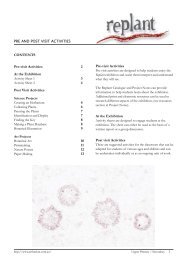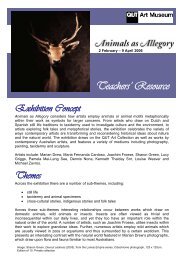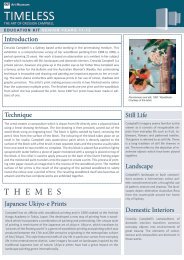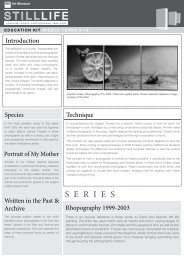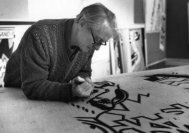Clifton Pugh - QUT Art Museum
Clifton Pugh - QUT Art Museum
Clifton Pugh - QUT Art Museum
Create successful ePaper yourself
Turn your PDF publications into a flip-book with our unique Google optimized e-Paper software.
About the theme<br />
Education Kit<br />
The Australian landscape is an important theme in <strong>Pugh</strong>’s paintings and by extension,<br />
also in his print works. He was an enthusiastic traveller and made trips to various remote<br />
areas of Australia. Many print works were inspired by his travels, which included trips<br />
to the Corner Country and its towns (Western NSW bordered by SA and Queensland),<br />
the Channel country of Queensland (including the Diamantina river that ‘runs’<br />
down toward Lake Eyre in S.A.), Arnhem Land (N.T.), the Bungle Bungles (W.A.), and<br />
South-West Tasmania.<br />
The desert was his favourite landscape after the bush of Dunmoochin. <strong>Pugh</strong> would make<br />
yearly trips to the desert, frequently to the small town of Tibooburra, which often acted<br />
as his base. Even after visiting the area for twenty years <strong>Pugh</strong> still declared that there<br />
were so many “superb sites” around the town that he still had not “exhausted the area<br />
even within two miles of the town.” Among the locations depicted are Dead Horse Gully<br />
(1985) and Tibooburra Homestead (1985). Spring may have been his preferred month<br />
for visiting as it offered a more temperate climate. But as he further noted “if there<br />
has been the usual seasonal rain, the desert is transformed and blooms in a sea<br />
of wildflowers. If not the parched dry country provides a range of beautiful colours”.<br />
He celebrated the local fauna in prints such as the Tibooburra Suite.<br />
Tibooburra, and the Corner Country is an area steeped in Australia’s explorer history.<br />
Milparinka, about 40 kilometres south, is close to Depot Glen where Charles Sturt<br />
camped for 6 months waiting for the drought to break. In untitled (Ruin with Plate)<br />
<strong>Pugh</strong> presents a view of Milparinka as seen from the veranda of its pub. While <strong>Pugh</strong><br />
was not so interested in depicting the plight of Australia’s early explorers, the three<br />
hazy figures in Mirage makes an oblique reference to one of the exploring groups<br />
searching for the inland sea. <strong>Pugh</strong>’s use of vibrant oranges (at times almost luminescent)<br />
and yellows convincingly conveys the heat of these inland locations.<br />
Toward the end of his life <strong>Pugh</strong> began to develop an interest in the sea and beach<br />
scenes. Saturday Afternoon, Bondi (1990) is one of the few beach scenes to be found<br />
among <strong>Pugh</strong>’s prints. The etching records a scene that caused <strong>Pugh</strong> some amusement.<br />
As the title suggests, one Saturday afternoon when <strong>Pugh</strong> was at Bondi Beach he saw,<br />
wandering in amongst numerous scantily clad females, bathing in the sun, three Jewish<br />
men in their traditional garments.<br />
Keywords<br />
desert suite drought<br />
wildflower homestead luminescent<br />
explorer atmosphere light<br />
portrait<br />
Page 25


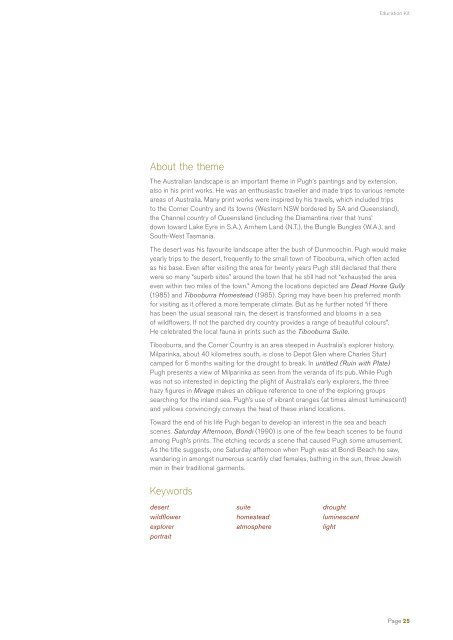

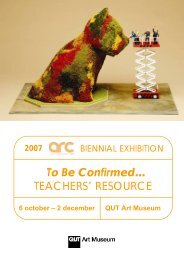

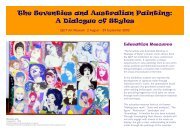
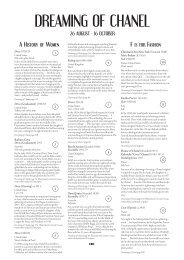
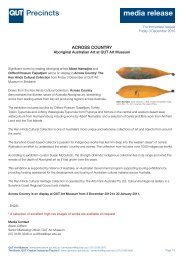

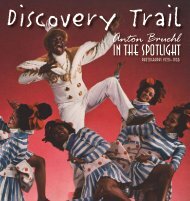
![Senior Years (10-12) [pdf - 4.5 MB] - QUT Art Museum](https://img.yumpu.com/38225334/1/184x260/senior-years-10-12-pdf-45-mb-qut-art-museum.jpg?quality=85)
